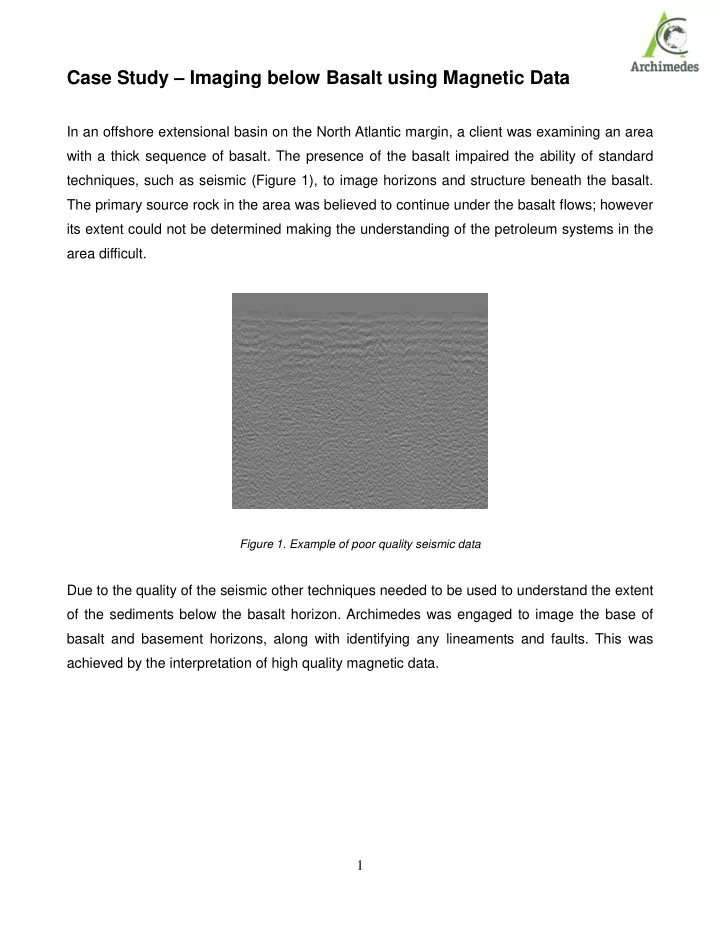

Case Study – Imaging below Basalt using Magnetic Data In an offshore extensional basin on the North Atlantic margin, a client was examining an area with a thick sequence of basalt. The presence of the basalt impaired the ability of standard techniques, such as seismic (Figure 1), to image horizons and structure beneath the basalt. The primary source rock in the area was believed to continue under the basalt flows; however its extent could not be determined making the understanding of the petroleum systems in the area difficult. Figure 1. Example of poor quality seismic data Due to the quality of the seismic other techniques needed to be used to understand the extent of the sediments below the basalt horizon. Archimedes was engaged to image the base of basalt and basement horizons, along with identifying any lineaments and faults. This was achieved by the interpretation of high quality magnetic data. 1
ARCHIMEDES APPROACH – Energy Spectral Analysis (ESA) for Horizon Interpretation Archimedes employed Energy Spectral Analysis (ESA) for horizon interpretation to image the base of basalt and basement horizons. The ESA Multi-Window Technique was used to define the plateaus that corresponded to these horizons (Figure 2). Based on these plateaus the ESA Moving Window Technique was then used to scan the area of interest enabling the depth and configuration of the horizons to be determined. Figure 2. Example of an ESA Multi-Window Technique result for a single location highlighting two strong plateaus. RESULTS - Energy Spectral Analysis (ESA) for Horizon Interpretation Final results of the Energy Spectra Analysis (ESA) horizon interpretation are shown in Figure 3. The mapping of these surfaces provided insight into the structural trends of the area particularly illuminating that the thickness of sediments below the basalt varies considerably 2
and is highly dependent on the basement horizon. . Figure 3. A 3D cross section showing the base of basalt and basement horizons from ESA interpretation ARCHIMEDES APPROACH – Automatic Curve Matching (ACM) for Fault Interpretation The faults were mapped using Archimedes’ proprietary Automatic Curve Matching (ACM) technique applied to profiles extracted from the high resolution Total Magnetic Intensity (TMI) grid. By varying the parameters in a range of theoretical models (dyke, plate and edge) and comparing observed and computed values, the location, depth, susceptibility and shape of the magnetic bodies were established. Only solutions with high confidence correlations were accepted. 3
These results were visualized in 3D. Magnetic lineaments were interpreted in planar view looking for continuity of solutions. The lineaments represent faults and other geological features such as dykes and lithological boundaries. Where the lineaments continued both in depth and laterally they were gridded in 3D as faults. RESULTS – Automatic Curve Matching (ACM) for Fault Interpretation Final results for the Automatic Curve Matching (ACM) showed strong magnetic lineaments at depths ranging from the basalt to within the basement. The results showed three major structural trends NNW, NE, and WNW. Figure 4 shows interpreted lineaments with faults gridded in 3D. Figure 4. Final results showing magnetic lineament interpretation with 3D fault surfaces. 4
SUMMARY Archimedes approach to high resolution magnetic data interpretation permitted the base of basalt and the basement horizons to be defined and mapped in a highly prospective area where seismic imaging was struggling to provide definition. A number of potentially attractive basement structures, some being possible targets for further exploration were identified. Feedback from the client indicated that the base of basalt was in line with expectations in areas where seismic was effective, and had a thickness that was expected from the known regional geology. Magnetic lineaments at different crustal depths were defined, and further interpreted locating significant faults. 5
Recommend
More recommend